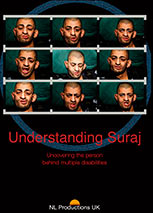
That person that I’m working with, I’ve got as much to learn from them as they have from anybody else around them. And I want to be open to that. And I don’t want their life to be a wasted life; that’s the other thing isn’t it. Somebody whose maybe going to live for 40 years and then die, and nobody managed to unlock that potential and nobody managed to get in there because that is just a wasted life. I don’t want that to happen, don’t have to have wasted lives do they. They’re human beings with just as much potential as anybody else, and that’s unlocking, let’s find out what’s in there. Let’s not let it be wasted; let’s learn from that person. – Rebecca Leighton in Understand Suraj DVD.
I was so excited to receive my copy of Understanding Suraj: Uncovering the person behind multiple disabilities from NL Productions UK, and I wasn’t let down.
This is a 45 minute DVD presented in four parts, including a background of Suraj narrated by his father, an observation of Suraj, and unpacking the current approach to being with Suraj. The story is honest, showing the disturbing self-injurious behaviour that Suraj had used for years, and using the voices of support workers and therapists to talk how they now approached Suraj.
Some viewers may struggle with the various strong English accents of narrators in Understanding Suraj. While the DVD appears to begin with subtitles, these don’t appear to continue (as far as I could see). While I’ve spent time with Graham Firth, one of the narrators, I did need to spend some time re-getting my ears around his northern accent. Similarly, just getting the quote above took me several minutes of re-listening to capture some of the phrases.
While the narrators discuss Intensive Interaction (Nind & Hewett www.intensiveinteraction.co.uk) as a framework underlying the communication approach with Suraj, it is not essential that you have background knowledge of the approach to follow the story. Following viewing the film, viewers may want to learn more about Intensive Interaction.
I recommend this DVD to anyone supporting people with profound intellectual and multiple disabilities, and particularly for those who may use self-injurious behaviours. I think this would be a great DVD for teams to watch and discuss. Some of the practices they see on the DVD may be the same as what they are already do, and some may be markedly different. It would be useful for teams to discuss whether they would consider using the methods with people they support, and unpack why they may or may not do things and the subsequent potential implications of these choices for them and the people they serve.
Speech pathologists and occupational therapists may also find Understanding Suraj an invaluable resource. It may challenge current practice or support ways of working. The DVD shows that dynamic interactions must be the centre communication supports (communication supports must go beyond personal communication dictionairies, chat books and object of reference).
I also think that this would be an excellent resource for staff at the NDIA – it gives such a rich picture of one individual, the experience of families and support workers, and the possibility of an improved life through working towards the best possible relationships between staff and the person they serve. These relationships need to be thought about, planned, informed and supported. Sometimes they occur naturally with amazing support workers. But too often, in line with Rebecca Leighton’s words (specialist speech and language therapist), the time is not given to unlock and spend the time to get to know the person in their full potential.
The DVD can be ordered through DL Productions UK – http://www.nlproductionsuk.co.uk/styled/DVD%20Understanding%20Suraj/. It is also available through Amazon UK, but this does not appear to be able to be shipped to Australia at the moment. A short intro the the video is also available on YouTube – http://youtu.be/inWvCsumQLk

